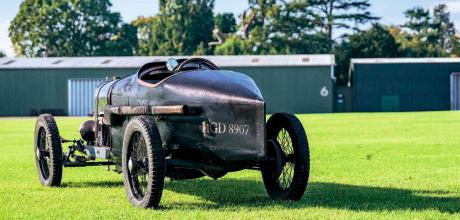1927 Salmson GS8 Brooklands
This ultra-rare 1927 Salmson GS8 Brooklands racer might be compact but, as Zack Stiling finds, it’s no angel to drive. Photography Reverendpixel.
LITTLE DEVIL
1927 Salmson GS8
Driving lesson in a rare vintage sports car
At the Shuttleworth Collection, the crackle of a vintage racing engine bursting into life is nothing unusual. Contained within the hangars is an array of pre-war road and racing-machinery, the nucleus of which was established by privateer racer Richard Shuttleworth in the 1930s. The engine being fired up today is not one of his, but he most likely crossed paths with it.
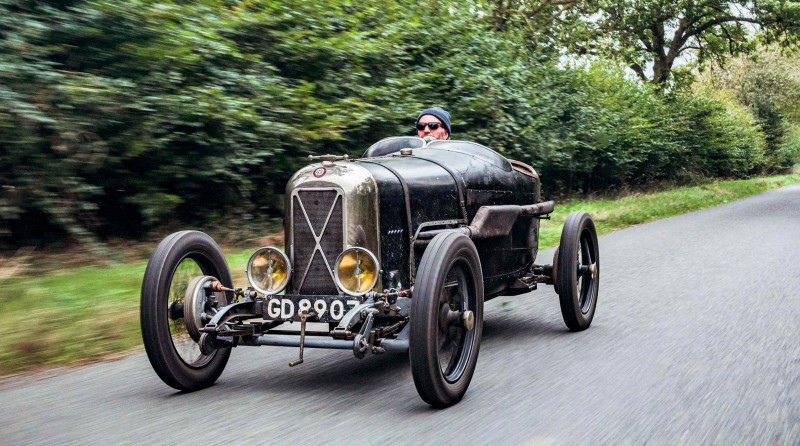
Naturally, Shuttleworth was a part of the Brooklands crowd and raced there on about 50 occasions in various cars from 1930 onwards. there’s a good chance that, in his earliest Junior Car Club races with his Austin Seven, he was pitted against this rather formidable Salmson, a prototype model with a rich Brooklands pedigree of its own. Chassis 21001 is the first Salmson GS8, one of only two built in 1927. While subsequent GS8s had two-bearing twin-cam engines and three-speed gearboxes with Salmson’s own wheels and hubs, this one has the 1100cc twin-cam engine from the GSS with its three-bearing, two-piece crankshaft, a four-speed gearbox and small 38mm Rudge hubs and wheels.
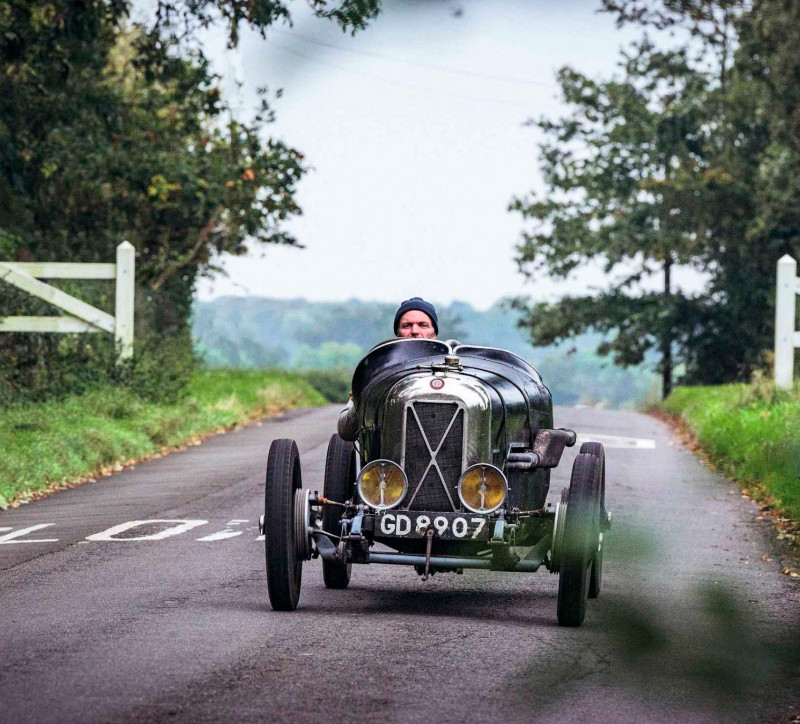
‘SERIOUS PROSPECTIVE BUYERS ELABORATELY EXPLAINED HOW THEY WOULD CHERISH THE CAR’
Salmson was still quite a young carmaker at that point, though it was held in high esteem by 1920s racing enthusiasts. Its engineering background started with pumps, and it began making aero engines as early as 1908 and supplied finished aeroplanes to the French military throughout the Kaiser War. Its first cars, introduced in 1919, were licence-built GN cyclecars, and it started building models of its own design from 1921.
Though we are referring to 21001 as a GS8, it was always called a Grand Prix Special in period. The new Grand Sport was called the GS8 because it was the 1928 model, making use of the left over underslung chassis that had been intended for the supercharged GP model; 150 were made but only 18 had become finished cars. However, GS8s were marketed in England as the Grand Prix, despite being quite distinct from the GP model. Production ran to 130 GS8s, 66 of which were dispatched to Britain.
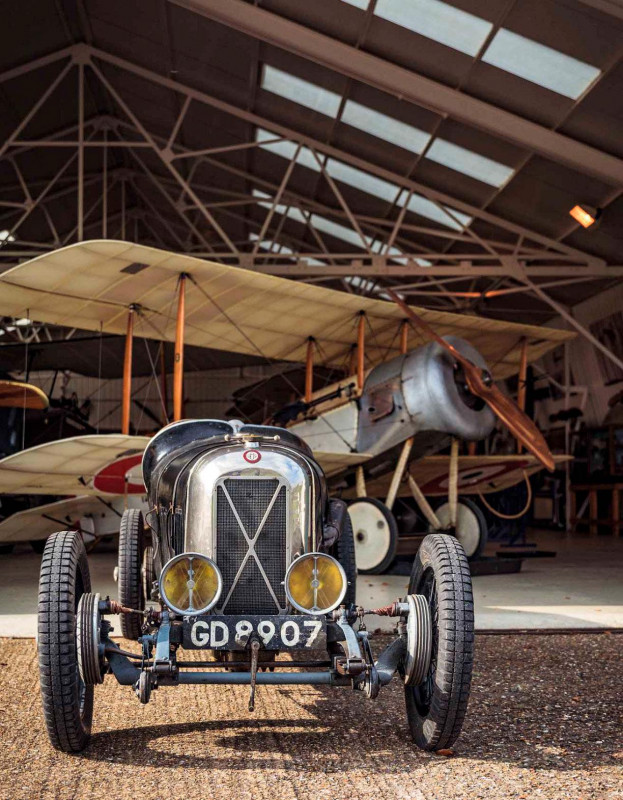
Our car was supplied new in November to Salmson’s British agent George Newman of Euston Road, who quickly found a buyer in occasional Brooklands fiend Geoffrey Battersby. He was no anonymous JCC back marker; with his GS8 he won a fair bounty, including silver and gold awards in the two races he entered. He had been a Salmsonist since 1923, when his father bought him a brand-new-four-pushrod model. After shortlived ownership of a 1927 10.4hp D-type, he eagerly took to this new car.
Battersby’s career with 21001 was successful but brief. He sold it in 1929 through Jack Bartlett, the great sports and racing car dealer of 27A Pembridge Villas, to George Harvey Noble, a man who would receive the insurmountable honour of being called ‘Mr Brooklands’ by no less a figure than William Boddy. After he’d cut his teeth with an Austin Seven and Alvis 12/50, the grey fabric-bodied biplace Salmson became Harvey Noble’s first serious racing car and he really took to it, campaigning it relentlessly from 1930 to 1932 in 15 Brooklands races plus the 1931 Skegness Sand Races, and managing to lap Brooklands at 77mph. At some point, the Salmson’s long tail snapped off after repeatedly bashing against the foot of the Test Hill, which one raced down in those days. It was sawn off and turned into a Manx-style bobtail with rear-mounted spare, until Harvey Noble part-restored it by fitting an aluminium tail from an Amilcar Grand Sport, but it was all replaced by a later owner.
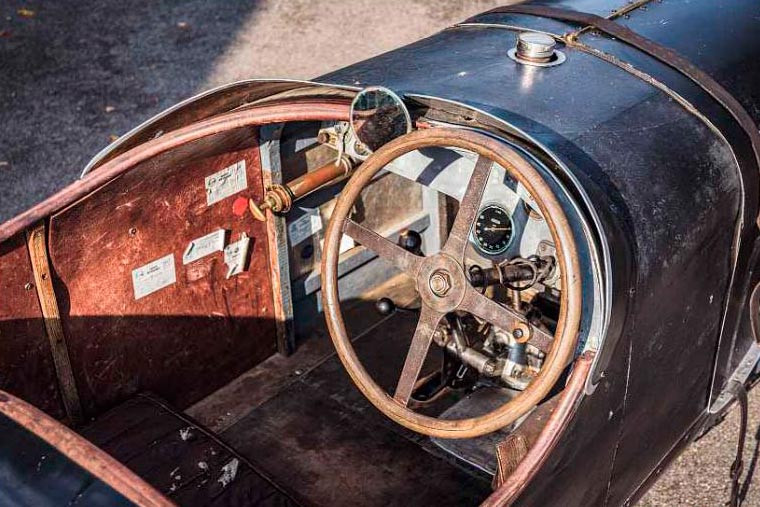
After Harvey Noble sold it to Victor Derrington, he still raced it as a team-mate of Derrington’s in the 1932 LCC Relay Race; Derrington was driving the supercharged model, GP602 (for which he is better-known), and CS Dickson-Geertz’s supercharged car (which Harvey Noble would buy in 1933) completed their team. Suffice to say, successive weekends of remorseless hard driving didn’t do much for the Salmson’s mechanical longevity and, when it next sold, it got passed from pillar to post.
By December 1932, it was with a Jack Barnes of Brighton, but before the year was out it was registered with Kenneth Rundle Crockatt of London SW5. Reginald Clifford Morley of Weston-super-Mare’s tenure was equally fleeting, and in July 1933 it was with C&K Motors on Putney Bridge Road. It sold very quickly to Norman Anderson Smith of Firswood, near Manchester, and benefited from his engineer’s touch. A committed enthusiast, he liked to get to Brooklands, Donington Park and Shelsley Walsh most weekends during the season, and passed time daydreaming about engineering improvements.
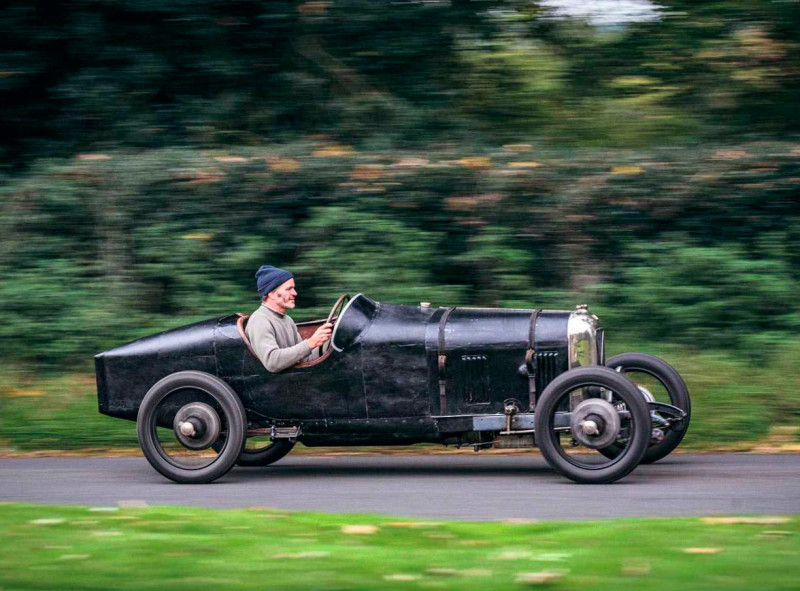
In 1936, Smith returned the Salmson to Pembridge Villas to be sold this time by Speed Models Ltd. The new owner was Harold George Waters, who lived in Horning, Norfolk, when not working as a master at Sandrock Hall prep school in Hastings. Waters was a true chains-and-dogs man, as he was selling a Frazer Nash when he bought the Salmson and had previously driven from Hastings to Horning in his home-made, rear-engined GN Shelsley Special, which he called the Gnurgle. By then the Salmson needed an engine rebuild, and Waters thought best to take it to Derrington’s Kingston-on-Thames workshop, which was the go-to place for Salmson tuning. Alas, Derrington failed to rebuild the engine to Waters’ satisfaction and their later correspondence grew decidedly catty.
Despite Smith’s generous advice, Waters’ period of ownership was cursed with difficulties and he advertised 21001 for sale in Motor Sport in 1938. He presumably found a buyer after extracting himself from beneath the avalanche of interested mail that poured through his letterbox. It was a more gentlemanly time then; all the serious prospective buyers elaborately explained how they would cherish the car and entreated Waters to look favourably on their case, like Elizabethan gallants petitioning their lord for his daughter’s hand.
No more is known until it surfaced post-war with one Jeremy Parker, who restored it and competed at Oulton Park in the mid-1950s, but did not campaign it extensively. It was only after it had been bought by the late David Lee in 1982 that the Salmson really came back with a vengeance. Once again, 21001 was competing and scooping up awards as a result. Lee sprinted, trialled and rallied the car with the VSCC for more than 30 years, tuning the engine as he went. Skilfully, he milled open the side of the cylinder head to improve the porting and fitted a pair of 1 ¼ in SUs.
The car’s present custodian is Mickey Hudson, swashbuckling VSCC racer and incorrigible light-car addict, who purchased it from Lee in 2006. It forms part of his stable of Salmsons and Austin Sevens, and will be familiar to readers who frequent vintage hill-climbs and sprints, as Hudson believes in using his cars as originally intended.
Immediately, he sourced the correct GS8 crankcase for it in France, as it had been using a twin-cam item that had presumably been fitted before the war to keep the engine soldiering on that little bit longer.
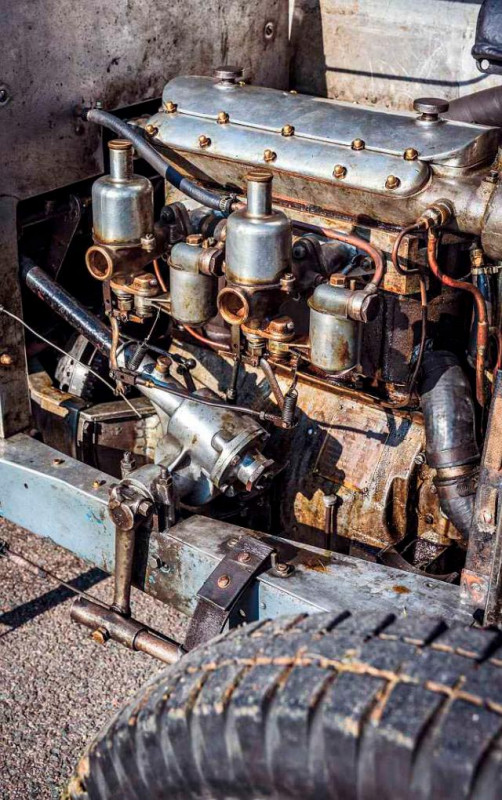
‘I have worked through it piece by piece without ever taking it all apart,’ says Hudson. ‘It has a new crank and set of rods but still retains the original trough-and-dipper lubrication. New camshafts with increased lift and duration help the cause. Cast aluminium Simca brake drums are now fitted all-round to replace the original pressed-steel ones. It’s ended up with SUs, and why not? It’s been an English car all its life. It had something from a 1970s MG Midget when I bought it, but now it’s got bronze-bodied SUs from an Aston Martin International.’ In fact, Waters was discussing fitting SUs back in 1937.
‘It had a yellowy bonnet, black body and blue chassis when I bought it, which never quite worked. I modified the existing body just by adapting the ash frame, extending the tail and covering it with 1.5mm birch ply and muslin doped on with rabbit glue. ’Most racing Salmsons had fabric bodies, albeit of the padded type. In this style, 21001’s body is somewhat reminiscent of early aircraft construction, and it looks quite at home among Shuttleworth’s Great War fighters. Hudson continues: ‘The body had been on it a long time, so I didn’t want to lose that part of its history, but I don’t feel like the bad man for mucking about with it as the original body had already gone.
‘I have used it almost on a daily basis since sorting it out – school runs, my commute to the workshop, and supermarket shopping, as well as racing it at Montlhéry, Angoulême and Cadwell Park and sprinting it at Prescott and Curborough. It would feel a bit mean to trial it, although I’m sure it would be a very good trials car. The tall rear axle ratio makes it fairly uncompetitive at VSCC events but it is a great road car, happily cruising at 70mph.’
Out in the Bedfordshire lanes, Hudson doesn’t hesitate to show the local traffic how a nonagenarian racing car goes – pretty rapidly – and he waxes lyrical about it. ‘When I first bought it, because it had been trialled it had a five-to-one axle ratio, which meant it was really lively up to 65mph but it was revving its nuts off, which is not much good on the road. Now it’s 3.75-to-one, which gives 21mph per 1000 revs. Four thousand revs in top is 85mph, which it’ll do. It’s still effectively a cyclecar and doing 80mph is more than enough.
The thought of lapping Montlhéry or Brooklands at that speed is terrifying. It’s very different from a Frazer Nash, surprisingly. In a ’Nash, you feel that you’ve got no diff, but in the Salmson you forget. It’s lovely to drive.’
It’s fair to say that ‘lovely to drive’ does not necessarily mean easy, though. ‘I’ve only just put new gears in it but it used to be a pain because they were all completely worn out. It might be because it’s got a very light flywheel that you have to be quick to shift. The revs drop off as soon as you push the clutch in.’
As disconcerting as the gearbox can be on the road, it comes more naturally while racing and when focused on quick changes. ‘The problem is,’ says Hudson, ‘because it runs with no wings, I’m in the racing car class, which has some very fast single-seaters. It’s not slow and I’m never last, but it’s not really an 1100cc racing car – it’s a sports car running with no wings. I’ve tried making wings but I can’t make them look pretty. Plus, running in the sports car class means I’d have to get up earlier.’
I take the wheel of the Salmson feeling more than a little apprehensive, mainly because of Hudson’s repeated emphasis on the trickiness of the gears. Because of the roller on it, the accelerator wants only a very light touch but, once that becomes natural, the progression upwards through the gears presents no particular difficulty as I aim for lightning-fast changes. Downshifts, on the other hand, are considerably more difficult and take quite a bit more practice before they can be executed smoothly.
Trundling along in the high gears gives me a more general feel for the machine, the most unexpected feature of which is the heavy steering, which is surprising for a lightweight car. It feels good, though, with any input to the steering wheel transferred with precision to the tarmac, plus there is no seesawing to correct play and it lightens up nicely at proper speeds. The brakes are reassuringly effective, so it all feels satisfyingly controlled in spite of the great responsibility that goes with piloting such a machine.
My all-too-fleeting drive is invaluable as a crash course in operating a vintage racing car, but it also teaches just how deceptive appearances can be. Older, larger cars have turned out to be gentle giants, but the Salmson is a devilish little beast if ever there was one. Devilish perhaps, but also exhilarating and a highly satisfying car to master. If all Salmsons are as challenging and rewarding in equal measure as the GS8, owning four, as Mickey Hudson does, suddenly makes perfect sense.
THANKS TO the Shuttleworth Trust, www.shuttleworth.org
Above Wingless bodywork means this sports car races against some ‘very fast’ single-seaters in VSCC events. Top left, and right Two seats in step formation allow for a riding mechanic without unnecessary width; compact bodywork does very little to shelter its occupants.
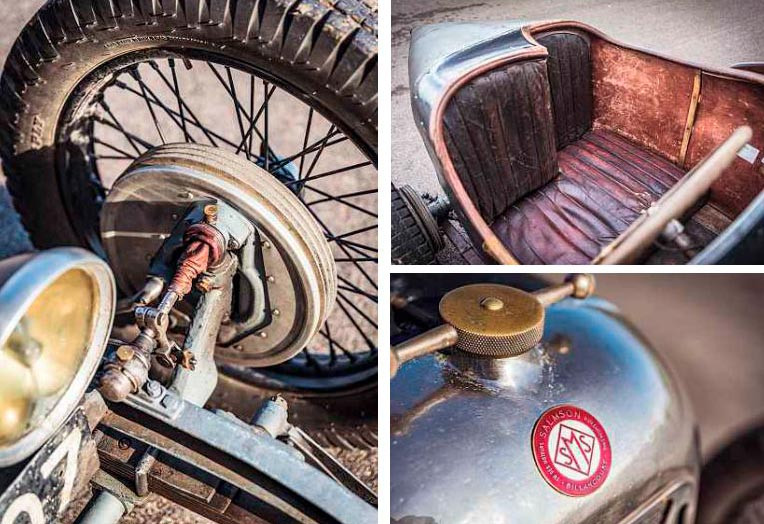
Clockwise, from left Bare cockpit is focused on driving, not luxury; owner Mickey Hudson describes the Salmson as ‘lovely to drive’; twin-cam four-cylinder with twin SU carburettors.
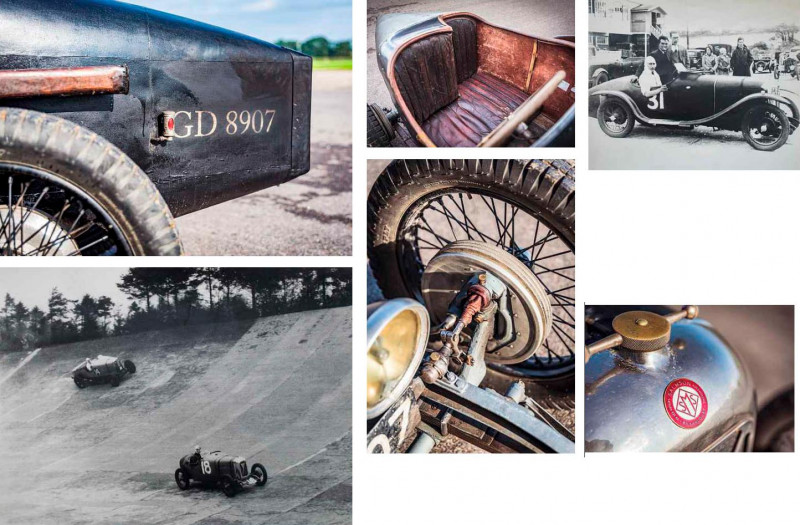
Clcokwise, from facing page With Great War fighters at the Shuttleworth Collection; tail section is a recent piece of work; George Harvey Noble raced the Salmson 15 times at Brooklands, becoming the 1100cc class winner.
TECHNICAL DATA FILE 1927 Salmson GS8 Brooklands
- Engine 1087cc DOHC four-cylinder, two SU carburettors
- Max Power c50bhp @ 4400rpm
- Max Torque c87lb ft @ 3200rpm
- Transmission Four-speed manual, rear-wheel drive, straight-cut final drive with no differential
- Steering Worm and sector
- Suspension Front: beam axle, semi-elliptic leaf springs, friction dampers. Rear: live axle, quarter-elliptic leaf springs, friction dampers
- Brakes 250mm drums from 1940s Simca
- Sport, original Perrot rod actuation
- Weight c475kg
- Top speed c85mph


